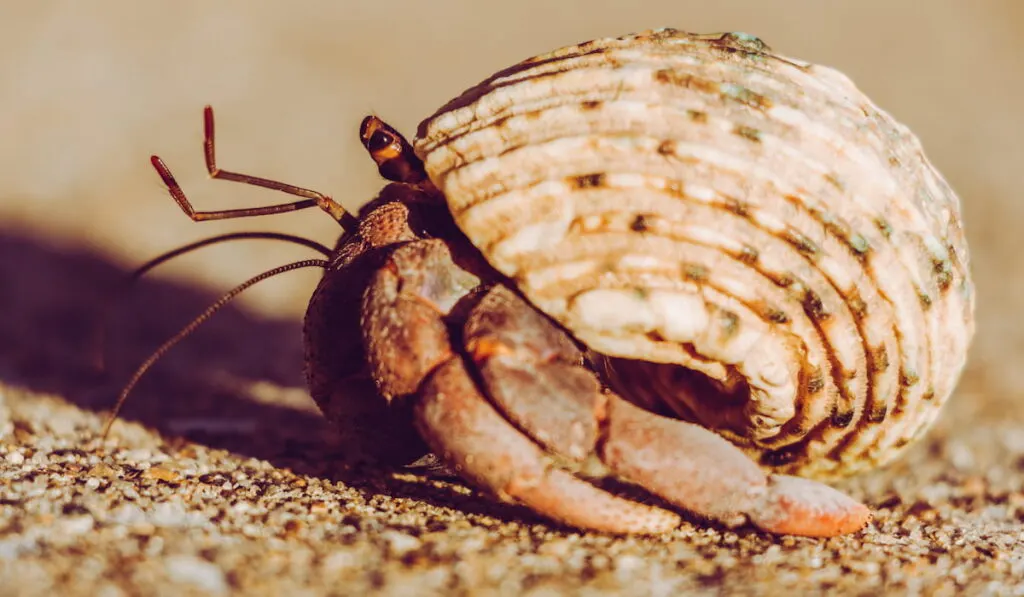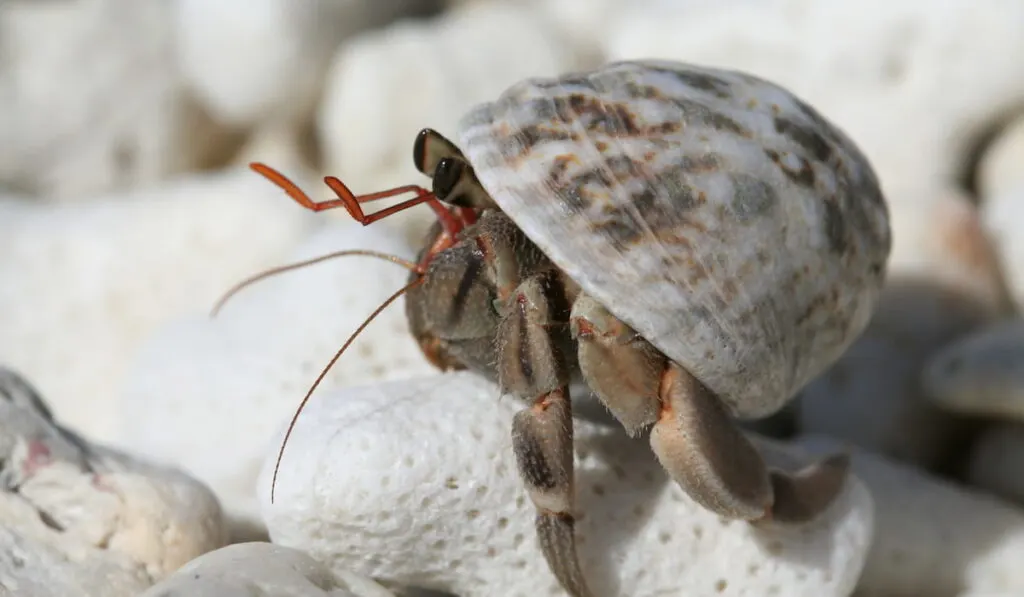You may have noticed lately that your hermit crab is starting to shed its shell. You may be wondering whether it has fallen ill or if something is wrong. While this may seem like something to be concerned about, it’s normal and is no cause for concern!
Do hermit crabs molt? Hermit crabs do molt to allow themselves to grow. During the molting process, hermit crabs shed their current exoskeleton. At that time, hermit crabs may grow a new shell or switch to a larger shell if provided.

Molting is a normal and healthy process for hermit crabs. To help you know what to expect from the process, we’ll explain why hermit crabs molt, how often, what the cycle is like, and ways to tell if your hermit crab is going to be molting soon.
Table of Contents
Hermit Crab Molting: Why, How Often and What It Entails
Molting is a normal, healthy process for hermit crabs. However, the process of molting – shedding an existing exoskeleton and growing or moving into a new one – might seem unusual to those unfamiliar with it.
Why do hermit crabs go through this process? How often do hermit crabs molt? What can you expect from the process (and your hermit crab)? Let’s take a look.
Why Hermit Crabs Molt
Hermit crabs may molt for a variety of reasons, sometimes based on their growth rate, health, environment, and physical traits. Below are the main reasons for hermit crabs molting.
Regular Molting
Typically, regardless of other factors, hermit crabs molt about every 18 months.
Regular molting every 18 months is a part of a hermit crab’s life and growth and is to be expected. Sometimes, smaller hermit crabs may molt a bit sooner or more frequently than other hermit crabs, but that’s not a regular occurrence (source).
Shell Has Been Outgrown
If a hermit crab has outgrown or become too small for its current shell (also called its exoskeleton), it may begin the molting process.
Just like humans, the bodies of hermit crabs grow throughout their lives. In order to have a shell large enough to fit its body in and continue to grow, a hermit crab will molt and grow a new shell (exoskeleton).
The Hermit Crab Molting Process
This process is normal and healthy, but it’s very important for hermit crab owners to know what to expect.
Let’s take a look at the molting process from beginning to end so that you know just what to expect. First things first: no matter what – don’t disturb a hermit crab throughout any part of the molting process!
Pre-Molt
The pre-molt stage, scientifically referred to as proecdysis, is the first stage. of molting for hermit crabs.
During this stage, a hermit crab’s new exoskeleton starts to place underneath the old one. The hermit crab begins to stow away food, water, and salts necessary for it to survive during the shedding process.
This stage may take a few days to a week, depending on the size of the hermit crab.
Molt
The molt stage, scientifically called ecdysis, is when the hermit crab’s stored salt and water build pressure to break the old exoskeleton. During this stage, the exoskeleton breaks and sheds.
Hermit crabs are especially vulnerable during this stage (after all, they don’t have their shell!) and need a lot of privacy and protection. Hermit crabs also lose most, if not all, of their muscle control at this time. They tend to look very limp and lethargic (source).
This stage is the shortest of all the stages, and can again last several days to a week – the timeline varies on the size of the hermit crab.
Post-Molt
Scientifically referred to as metecdysis, the post-molt stage is when the hermit crab begins to form its new exoskeleton.
In order to form the new exoskeleton, the hermit crab may eat its old exoskeleton. At this stage – which also lasts several days to a week – the hermit crab regains some muscle control and mobility.
Intermolt
Intermolt, scientifically called anecdysis, is the last stage in the molting process. At this stage, the new exoskeleton starts to expand and get stronger as the hermit crab eats and drinks.
This stage is essentially the bout of “normal life” for the hermit crab after it molts and until the next molting time (source).

How to Tell If a Hermit Crab Is Molting – Or Will Be Soon
By now, you know that hermit crabs do molt – and it’s a normal, healthy process that happens about every 18 months.
Thankfully for owners, there are some key ways to tell. It’s just as important for hermit crab owners to know the signs of molting as it is for them to know about the actual molting process.
Lifeless or Just Molting?
Just why is it so important for hermit crab owners to be familiar with the tells of molting? Because of the state hermit crabs take on when they’re molting, they can often be mistaken for dead instead of just molting.
When hermit crabs molt, they become a bit limp and lifeless – specifically in the second stage of molting. As their exoskeleton sheds, they lose muscle control and become unable to move as a result. Once their new exoskeleton begins to form, they regain muscle control.
The limp and lifeless state hermit crabs take on during molting can cause a lot of confusion for hermit crab owners – they may wonder if their hermit crab is just molting or if it has actually passed away.
Thankfully, there are specific ways to tell if a hermit crab is molting.
Physical Changes
If your hermit crab is getting ready to molt, it will likely change a bit in physical appearance.
Hermit crabs beginning the process may take on traits like:
- Cloudy or dull eyes
- Eye stalks drifting away from each other to form more of a “V” shape
- Newly regenerating limbs – look like a small, clear nub on the end of a previously missing limb
- Weak, sagging legs
- Chalky, ashy exoskeleton (shell)
- Off-white colored legs and claws
- Antennae that look tangled
All of these physical changes may seem concerning – after all, they’re physical changes that most would think are unhealthy. However, when hermit crabs take on any or all of these traits, it typically indicates molting.
Increased Digging
Hermit crabs that are getting ready to molt may increase their digging. In the wild, hermit crabs dig underground to go through the molting process.
Hermit crabs need a lot of darkness and a protected space when molting and may begin to dig more often in order to create such a space.
A Decrease in Other Activity
When a hermit crab is going to begin molting, it’ll likely decrease all other activity (besides digging or after digging) and become somewhat lethargic. Hermit crabs may hide in their shells or in other areas more often and for longer periods of time.
More Eating and Drinking
Hermit crabs that are almost ready to begin the molting process can be seen eating more and spending more time in their freshwater and saltwater dishes. A reserve of food, water, and salt allows hermit crabs to break their old exoskeleton and survive the process.
At this point, hermit crabs may be seen with a black pouch or “bubble” on the left side of their stomachs that holds excess water and fat. However, not all hermit crabs exhibit this trait.
Final Thoughts
If you’ve seen your hermit crab exhibit some unusual behavior like shedding its shell, you may be concerned that something is wrong. Usually, the opposite is true – the hermit crab is likely just molting.
Molting is a natural, normal, and healthy aspect of every hermit crab’s life, so it’s important for hermit crab owners to be familiar with what it looks like and how it works.
If your hermit crab is beginning to molt, make sure to give it protection and privacy – and then feel good knowing humans don’t have to go through the same process!
